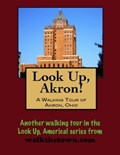There is no better way to see America than on foot. And there is no better way to appreciate what you are looking at than with a walking tour. Whether you are preparing for a road trip or just out to look at your own town in a new way, a downloadable walking tour is ready to explore when you are.
Each walking tour describes historical and architectural landmarks and provides pictures to help out when those pesky street addresses are missing. Every tour also includes a quick primer on identifying architectural styles seen on American streets.
There was industry in Akron before rubber. There was a thriving clay manufacturing trade but other towns were churning out pottery and more of it. There was a bustling mill community, especially under Ferdinand Schumacher, the Oatmeal King, but other emerging grain processors were closer to the vast wheat fields being settled on the Great Plains. Few towns are as closely associated with a single product as a Akron is to rubber but there was plenty of serendipity on the path to Akron becoming the Rubber Capital of the World.
With the Goodyear, Goodrich, Firestone and General Tire in place, no town in America grew like Akron. The population of 70,000 in 1910 and tripled to 210,000 in 1920. To keep up Akron swallowed rival communities and buildings were seemingly erected overnight. Most of the significant buildings seen today were constructed during that boom time until 1931, recasting the Akron streetscape from its origins as a canal town founded in 1825 by Simon Perkins. But our walking tour will start hard by the vestiges of the Erie & Ohio Canal, at a high point on the historic waterway that gave birth to a town named for the Greek word "akros," meaning "high place"...

